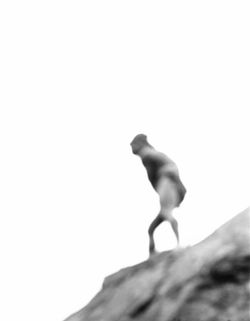 |  |  |  |
|---|---|---|---|
 |  |  |  |
 |  |  |  |
 |  |  |  |
 |
MONUMENTO
What we leave behind
Original Text by Alejandra Wolff
The work Monuments, by the artist Alfredo Méndez, consists of a series of black and white photographs that expose, through blurring, the figure of a national hero enabled by the patrimonial ruling party. To the limit of their disfigurement, these statues have been "overexposed" to the space of the unrecognizable. Submitted to the registration of optical technology, the patriotic emblems installed in the city seem to tremble before their imminent dematerialization. Captured at the limit of this fading, these monuments literally and visually transform their solidity into a gaseous state to become stain, residue, oblivion, or blindness. Alfredo's photographs testify to the debates that revolve around a patrimonial body that is in dispute. His images suspend the customary and habitual transit of the encounter with the official imaginary that they intend to represent. The white background supports the perspective from which we are used to looking at the hegemonic order. But this time, the extreme light from the sky does not illuminate, it blurs the fixity of a past that is in question. These photographs reveal the doubt about who we are, reveal the ambiguity of the scaffolding that has built our history, and subtly expose the fading of an imaginary past that no longer represents us. The monumentality with which official history has been represented through military "conquests", the stereotyped equine bodies and the rigidity of the idealized power of male bodies, are literally vaporized in these images. The optical register of modern technology relocates the urban environment in which these monuments are located, extracting them from the public space from which they had been perpetuated until yesterday. Monuments is a series of images that expose the crisis of the institutional discourse under which hegemony has given rise to memory, and it is not by chance that it is the photographic record that evidences it, since death haunts the past just as Memories are documented in the strangeness of seeing ourselves captured in the fixed gesture of the photo. In these images, the monumental scale that determines the meaning and value of nationalist spectacles is reduced to the chiaroscuro stain of a spectrum, evoking a gaze that seems to disappear among those of us who, from the ground, observe the beginning of a new project.
